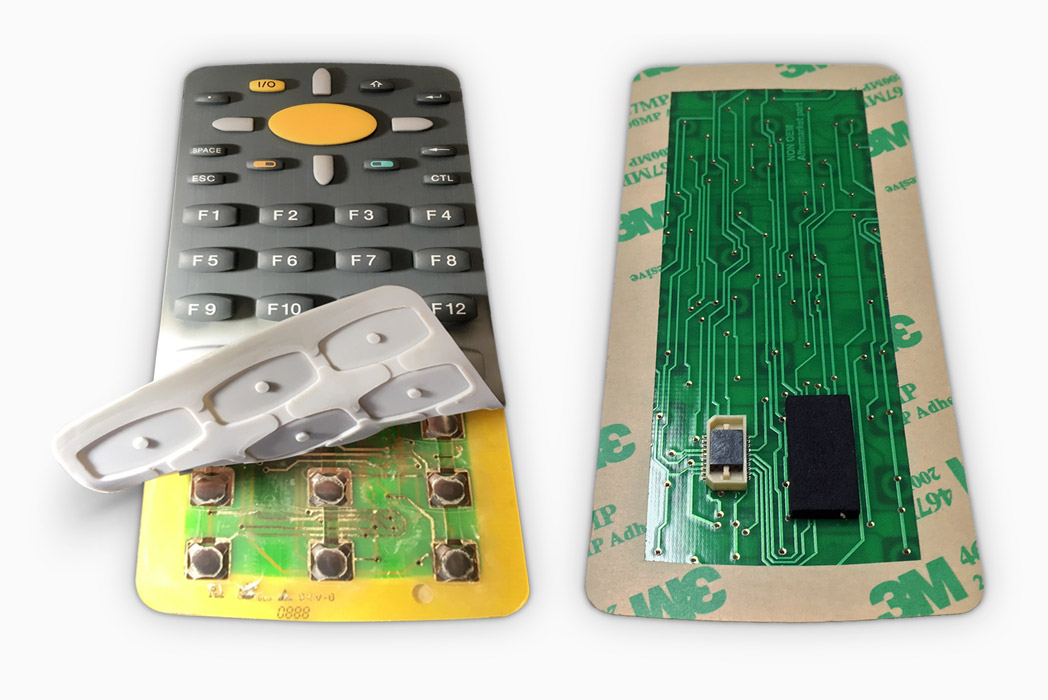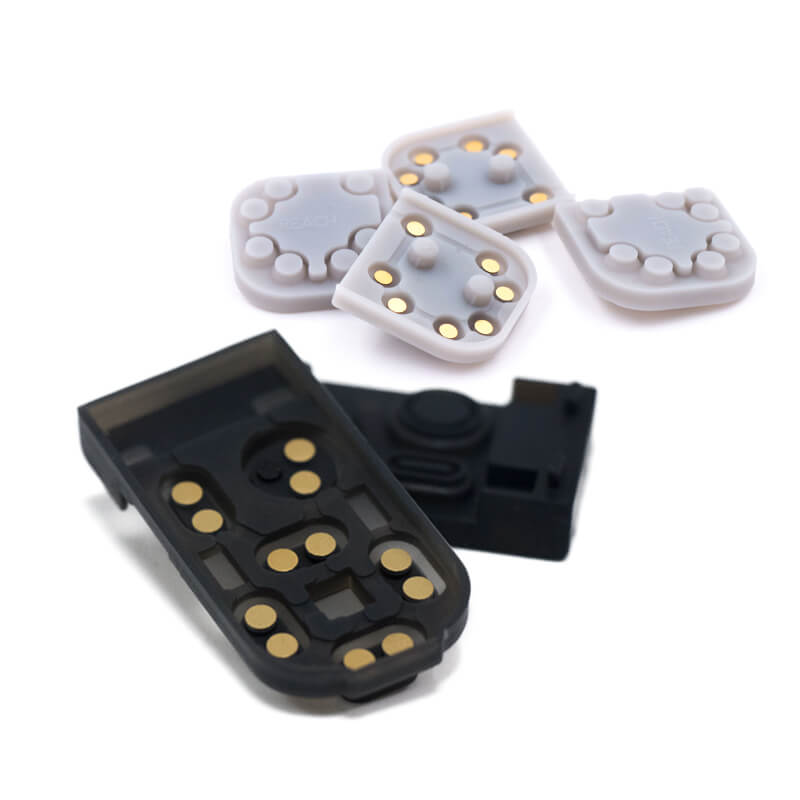Comparing Rubber Keypads to alternative keypads: What You Should Know
Wiki Article
Discovering the Production Process Behind Rubber Keypads and Their Relevance in Modern Instruments
Rubber keypads are crucial in the functionality of modern-day devices. Their production process involves cautious option of products and exact strategies. Keypads are created to boost user communication while guaranteeing durability and integrity. Understanding just how these elements are made discloses their importance throughout numerous applications. What factors add to their efficiency, and just how do these components affect user experience? The solutions may reshape assumptions of this day-to-day innovation.Introduction of Rubber Keypads and Their Applications

Rubber keypads are versatile parts widely used in different digital tools, varying from customer electronic devices to industrial equipment. Their design enables a tactile feedback, making them a perfect option for applications needing individual interaction. Typically located in items such as remote controls, calculators, and clinical tools, rubber keypads promote simplicity of usage and availability.
In industrial setups, they serve crucial features in equipment and control panels, where resilience and resistance to environmental elements are crucial. The non-slip surface enhances hold, advertising dependability popular conditions. Furthermore, their light-weight nature and personalized shapes enable suppliers to develop tailored options that fit particular needs. With improvements in modern technology, rubber keypads remain to develop, including attributes like backlighting and enhanced sensitivity. Overall, their versatility and useful benefits contribute considerably to the effectiveness of different tools across several industries.
Products Made Use Of in Rubber Keypad Manufacturing
Keypad making counts on a choice of products that enhance both capability and resilience. The main product used in the production of rubber keypads is silicone rubber, understood for its excellent strength and adaptability. This product permits keypads to hold up against repeated pressing without shedding shape or performance. In addition, thermoplastic elastomers (TPE) are usually used as a result of their convenience of molding and ability to give a soft-touch feel.Coloring agents, such as pigments, are incorporated to assure dynamic, long-lasting tones that improve visual allure. In addition, additives like anti-UV representatives and flame resistants might be blended into the rubber to improve weather condition resistance and safety conformity. The choice of products directly affects the keypad's tactile response, longevity, and general performance in numerous tools. Eventually, the mindful selection of these parts is crucial for the production of high-quality rubber keypads that meet consumer and market demands.
The Style Refine of Rubber Keypads
When creating rubber keypads, the design process plays a crucial function in establishing functionality and individual experience. Designers start by specifying the keypad's planned usage, thinking about aspects such as the device it will go along with and the target user demographic. This preliminary phase consists of sketching formats that prioritize ergonomic facets, making certain the tricks are quickly available and appropriately spaced.Next off, designers concentrate on the responsive feedback wanted from the keypads, which affects the option of products and essential shapes. Prototyping is crucial in this stage, permitting developers to evaluate numerous layouts for comfort and responsiveness.
Production Techniques for Rubber Keypads
The manufacturing procedure for rubber keypads includes a collection of exact methods that ensure quality and capability. Liquid silicone rubber (LSR) is commonly made use of due to its longevity and adaptability. The process starts with blending the raw materials, including silicone, colorants, and curing representatives. This mixture is then infused into molds made to form the keypads precisely.
Complying with shot, the molded keypads undertake healing, a heating procedure that solidifies the product (Rubber Keypads). This is normally carried out in a press, making sure the keypads attain the preferred hardness and resilience

Quality Assurance Actions in Production
To ensure that rubber keypads fulfill high criteria of high quality and performance, rigorous top quality control procedures are executed throughout the manufacturing procedure. These actions begin with resources evaluation, ensuring that only the highest-grade elastomers are utilized. Throughout the production phase, operators perform normal checks to check parameters such as temperature level, pressure, and blending times, crucial for achieving consistent product high quality.Post-production, each batch of keypads goes through extensive screening, consisting of responsive action evaluations and sturdiness tests to examine efficiency under various problems. Aesthetic assessments are also carried out to determine any type of problems, such as bubbles or incongruities in appearance. Furthermore, compliance with industry standards is verified, making certain that the keypads fulfill safety and capability criteria.
The Function of Innovation in Keypad Development
Innovation plays an important duty in the advancement of rubber keypads by allowing innovative production strategies that enhance accuracy and effectiveness. In addition, innovative product option permits for improved resilience and responsiveness in keypad efficiency. These developments not only simplify manufacturing but additionally elevate the total quality of the final item.Advanced Production Techniques
Improvements in production strategies reinvent the production of rubber keypads, boosting both performance and precision. Technologies such as shot molding and 3D printing have transformed traditional processes, making it possible for makers to create complicated styles with decreased waste and boosted turnaround times. Automation plays a crucial function in this advancement, enhancing assembly lines and lessening human mistake. Furthermore, computer-aided style (CAD) software program permits intricate customization, guaranteeing that keypads meet particular user requirements. basics Quality assurance measures have actually also advanced, incorporating real-time tracking systems that detect problems early in the manufacturing cycle. These developments not only boost the resilience and functionality of rubber keypads however also sustain the growing need for customized services in various industries, from consumer electronic devices to automotive applications.Cutting-edge Material Choice
The evolution of making strategies has led the way for cutting-edge material selection in rubber keypad advancement. Developments in polymer science have actually presented materials that boost longevity, versatility, and responsive feedback. Producers now utilize thermoplastic elastomers (TPE) and silicone substances, which supply exceptional resistance to put on and ecological variables. These products enable for the development of keypads that can withstand prolonged usage while maintaining visual allure. Furthermore, the assimilation of coverings and ingredients enhances functionality, such as boosting hold and reducing friction. The option of materials is vital, as it directly impacts the performance and longevity of keypads in different gadgets, from consumer electronic devices to industrial equipment. This innovative strategy remains to form the future of keypad style and use.The Impact of Rubber Keypads on Customer Experience
Rubber keypads substantially influence customer experience through their boosted tactile reaction, which permits even more accurate interaction. Additionally, their resilience and longevity add to regular efficiency over time, minimizing the demand for frequent substitutes. This combination of attributes makes rubber keypads a favored choice in various applications, inevitably affecting user satisfaction.Improved Tactile Feedback
Enhancing tactile response substantially influences user experience, especially in devices that rely upon keypads for communication. Rubber keypads offer an one-of-a-kind mix of soft qualities and resilience, enabling users to feel distinct comments with each press. This feedback strengthens a sense of control and precision, vital in applications varying from smartphones to industrial tools. Users often report higher fulfillment and efficiency when engaging with gadgets that feature well-designed rubber keypads, as they promote quicker and much more exact input. Additionally, the ergonomic style of these keypads can reduce finger fatigue, advertising longer usage durations without discomfort. In general, the enhanced tactile response provided by rubber keypads considerably contributes to a more pleasurable and instinctive customer experience in contemporary technology.Longevity and Longevity
An essential aspect of user experience with rubber keypads depends on their toughness and durability. These keypads are made to stand up to comprehensive usage, standing up to damage that frequently impacts various other products. The durable nature of rubber guarantees that keypads keep their capability and appearance with time, which is essential for gadgets often utilized in numerous settings. Users profit from the integrity of rubber keypads, as they can withstand exposure to dust, temperature, and dampness changes without degrading. This durability not just enhances user contentment yet likewise minimizes the need for regular substitutes, eventually adding to cost-effectiveness for manufacturers. Essentially, the sturdiness of rubber keypads considerably influences the total performance and customer experience in modern devices.Regularly Asked Questions
For How Long Do Rubber Keypads Typically Last in Gadgets?
Rubber keypads typically last between 5 to one decade, depending upon usage, ecological variables, and high quality of products used (Rubber Keypads). Regular wear and tear can shorten their lifespan, influencing capability and individual experience over timeCan Rubber Keypads Be Personalized for Details Applications?
Rubber keypads can undoubtedly be tailored for certain applications, permitting alterations in dimension, shade, texture, and shape. This versatility allows producers to create customized solutions that fulfill varied customer requirements and enhance functionality in numerous devices.Are Rubber Keypads Environmentally Friendly?
Rubber keypads are frequently not thought about eco-friendly as a result of their petroleum-based products. Nevertheless, advancements in sustainable manufacturing methods and the development of bio-based options are gradually improving their environmental influence in numerous applications.What Are Usual Problems Dealt With During Rubber Keypad Manufacturing?
Typical problems encountered throughout rubber keypad production consist of inconsistent material high quality, mold and mildew flaws, improper check my source healing times, attachment failings, and challenges in achieving accurate tactile comments. These troubles can lead to decreased product performance and client dissatisfaction.Exactly How Do Rubber Keypads Compare to Various Other Types of Trick Switches Over?
Rubber keypads use a softer feel and quieter procedure compared to mechanical switches, which give tactile feedback. Nevertheless, rubber keypads might wear faster and lack the precision that some customers favor in high-performance applications.The key product utilized in the production of rubber keypads is silicone rubber, recognized for its superb strength and versatility. When developing rubber keypads, the design process plays a crucial role in figuring out capability and user experience. Rubber keypads substantially influence customer experience with their enhanced tactile reaction, which enables for more accurate communication. Individuals commonly report higher fulfillment and effectiveness when engaging with tools that feature well-designed rubber keypads, as they assist in quicker and extra precise input. A vital facet of customer experience with rubber keypads lies in their Recommended Reading resilience and durability.
Report this wiki page